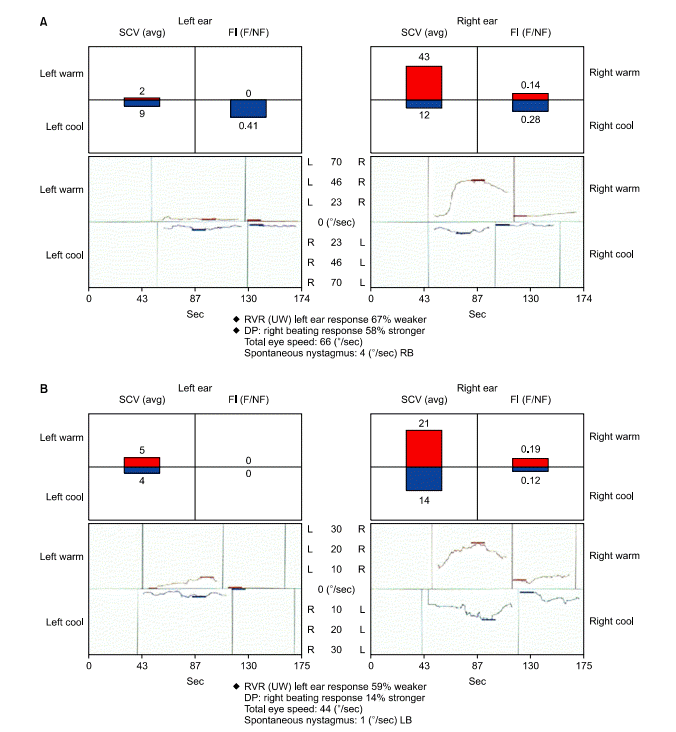Articles
- Page Path
- HOME > Res Vestib Sci > Volume 17(1); 2018 > Article
-
Case Report
양측 메니에르병으로 오인된 자가면역 내이질환 1예 -
김홍주, 최윤기, 김현지, 김규성

- Autoimmune Inner Ear Disease Mimicking Bilateral Ménièreʼs Disease: A Case Report
-
Hong-Ju Kim, Yoon-Gi Choi, Hyun Ji Kim, Kyu-Sung Kim

-
Research in Vestibular Science 2018;17(1):28-34.
DOI: https://doi.org/10.21790/rvs.2018.17.1.28
Published online: March 15, 2018
Department of Otorhinolaryngology-Head and Neck Surgery, Inha University College of Medicine, Incheon, Korea
- Corresponding Author: Kyu-Sung Kim Department of Otorhinolaryngology-Head and Neck Surgery, Inha University College of Medicine, 27, Inhang-ro, Jung-gu, Incheon 14913, Korea Tel: +82-32-890-3570 Fax: +82-32-890-3580 E-mail: stedman@inha.ac.kr
• Received: February 1, 2018 • Revised: March 6, 2018 • Accepted: March 7, 2018
Copyright © 2018 by The Korean Balance Society. All rights reserved.
This is an open access article distributed under the terms of the Creative Commons Attribution Non-Commercial License (http://creativecommons.org/licenses/by-nc/4.0) which permits unrestricted non-commercial use, distribution, and reproduction in any medium, provided the original work is properly cited.
- 8,050 Views
- 140 Download
- 2 Crossref
Abstract
- Autoimmune inner ear disease (AIED) is a rare disease, accounting for <1% of all cases of hearing impairment or dizziness. It is characterized by sensorineural hearing loss (SNHL) or vestibular dysfunction that results from an immunemediated process. Clinical features of AIED is SNHL that progresses over weeks to month with fluctuating hearing symptoms. Because there are no diagnostic laboratory and clinical feature, response to immunosuppressive therapy were important for diagnosis of AIED. Many diseases such as sudden SNHL and Meniere disease may also mimic AIED, a broad differential must be maintained in patients suspected of having AIED. We report a case of a 46-year-old female who presented with sudden hearing loss and vertigo. We could diagnose her as AIED with systemic lupus erythematous. The symptoms were improved treated with steroids.
서 론
증 례
고 찰
Acknowledgments
Fig. 1.Video head impulse test (vHIT). (A) The initial examination shows 0.17 gain decrease in the left lateral impulse test. (B) Two weeks later, the left lateral impulse test of vHIT shows 0.60 gain decrease. (C) Ten weeks later, gain of the left lateral impulse test was recovered.


Fig. 2.Caloric test. (A) The initial examination shows 67% canal paresis in the left ear. (B) Two weeks later, canal paresis of left ear shows 59%. SCV, slow-component velocity; FI, fixation index; F, fixation; NF, nonfixation; RVR, relative vestibular reduction; DP, directional predominance; RB, right beating; LB, left beating; RVR, reduced vestibular response; UW, unilateral weakness.


Fig. 3.Pure tone audiogram (PTA). (A) The initial examination shows hearing loss 30 dB in right ear and 45 dB in the left ear. (B) Two days later, the audiogram shows improvement of right side low tone hearing loss. (C) Twelve days later, the audiogram shows improvement of left side to 35 dB. (D) Ten weeks later, the audiogram shows improvement of both hearing loss. HL, hearing level; AC, air conduction; BC, bone conduction; SF, soundfield.


Fig. 4.Inner ear magnetic resonance imaging. There are no abnormal filling defect on T1 (A) and T2 (B) images at the level of the cochlea and vestibule. (C) T1 enhancing image at the level of the cochlea and vestibule shows no abnormal enhancement. (D) Fluid-attenuated inversion recovery image shows enhancement of left cochlea and vestibule (arrow).


- 1. Bovo R, Ciorba A, Martini A. The diagnosis of autoimmune inner ear disease: evi-dence and critical pitfalls. Eur Arch Otorhinolaryngol 2009;266:37–40.ArticlePubMed
- 2. McCabe BF. Autoimmune sensorineural hearing loss. Ann Otol Rhinol Laryngol 1979;88(5 Pt 1):585–9.ArticlePubMed
- 3. Park SN, Yeo SW, Park YS, Suh BD. Immune-mediated sensorineural hearing loss in a patient with ankylosing spondylitis. Korean J Otorhinolaryngol-Head Neck Surg 2000;43:663–6.
- 4. McCabe BF, McCormick KJ. Tests for autoimmune disease in otology. Am J Otol 1984;5:447–9.PubMed
- 5. Billings PB, Shin SO, Harris JP. Assessing the role of anti-hsp70 in cochlear im-pairment. Hear Res 1998;126:210–3.ArticlePubMed
- 6. Trune DR, Kempton JB, Mitchell CR, Hefeneider SH. Failure of elevated heat shock protein 70 antibodies to alter cochlear function in mice. Hear Res 1998;116:65–70.ArticlePubMed
- 7. Lee JM, Kim JY, Bok J, Kim KS, Choi JY, Kim SH. Identification of evidence for autoimmune pathology of bilateral sudden sensorineural hearing loss using proteomic analysis. Clin Immunol 2017;183:24–35.ArticlePubMed
- 8. Atturo F, Colangeli R, Bandiera G, Barbara M, Monini S. Can unilateral, pro-gressive or sudden hearing loss be immune-mediated in origin? Acta Otolaryngol 2017;137:823–8.ArticlePubMed
- 9. Broughton SS, Meyerhoff WE, Cohen SB. Immune-mediated inner ear disease: 10-year experience. Semin Arthritis Rheum 2004;34:544–8.ArticlePubMed
- 10. Mijovic T, Zeitouni A, Colmegna I. Autoimmune sensorineural hearing loss: the otology-rheumatology interface. Rheumatology (Oxford) 2013;52:780–9.ArticlePubMedPDF
- 11. Gazquez I, Soto-Varela A, Aran I, Santos S, Batuecas A, Trinidad G, et al. High prevalence of systemic autoimmune diseases in patients with Menière's disease. PLoS One 2011;6:e26759.ArticlePubMedPMC
- 12. Kanzaki J, Kanzaki S, Ogawa K. Long-term prognosis of steroid-dependent sen-sorineural hearing loss. Audiol Neurootol 2009;14:26–34.ArticlePubMed
- 13. García-Berrocal JR, Ibáñez A, Rodríguez A, González-García JA, Verdaguer JM, Trinidad A, et al. Alternatives to systemic steroid therapy for refractory im-mune-mediated inner ear disease: a physiopathologic approach. Eur Arch Otorhino-laryngol 2006;263:977–82.Article
- 14. Sismanis A, Wise CM, Johnson GD. Methotrexate management of immune-mediated cochleovestibular disorders. Otolaryngol Head Neck Surg 1997;116:146–52.ArticlePubMed
- 15. Harris JP, Weisman MH, Derebery JM, Espeland MA, Gantz BJ, Gulya AJ, et al. Treatment of corticosteroid-responsive autoimmune inner ear disease with metho-trexate: a randomized controlled trial. JAMA 2003;290:1875–83.ArticlePubMed
REFERENCES
Figure & Data
References
Citations
Citations to this article as recorded by 

- Sensorineural Hearing Loss of Suspected Autoimmune Etiology: Two Cases of Cogan’s Syndrome
Jungmin Ahn, Brian Kim, Kyoung Rai Cho, Young-Soo Chang
Korean Journal of Otorhinolaryngology-Head and Nec.2021; 64(12): 943. CrossRef - A Case of Autoimmune Sensorineural Hearing Loss Responding to Cytotoxic Agent
Yong Woo Lee, Jin Lee, Min-Beom Kim, Sun O Chang
Korean Journal of Otorhinolaryngology-Head and Nec.2019; 62(8): 470. CrossRef

 KBS
KBS
 PubReader
PubReader ePub Link
ePub Link Cite
Cite





